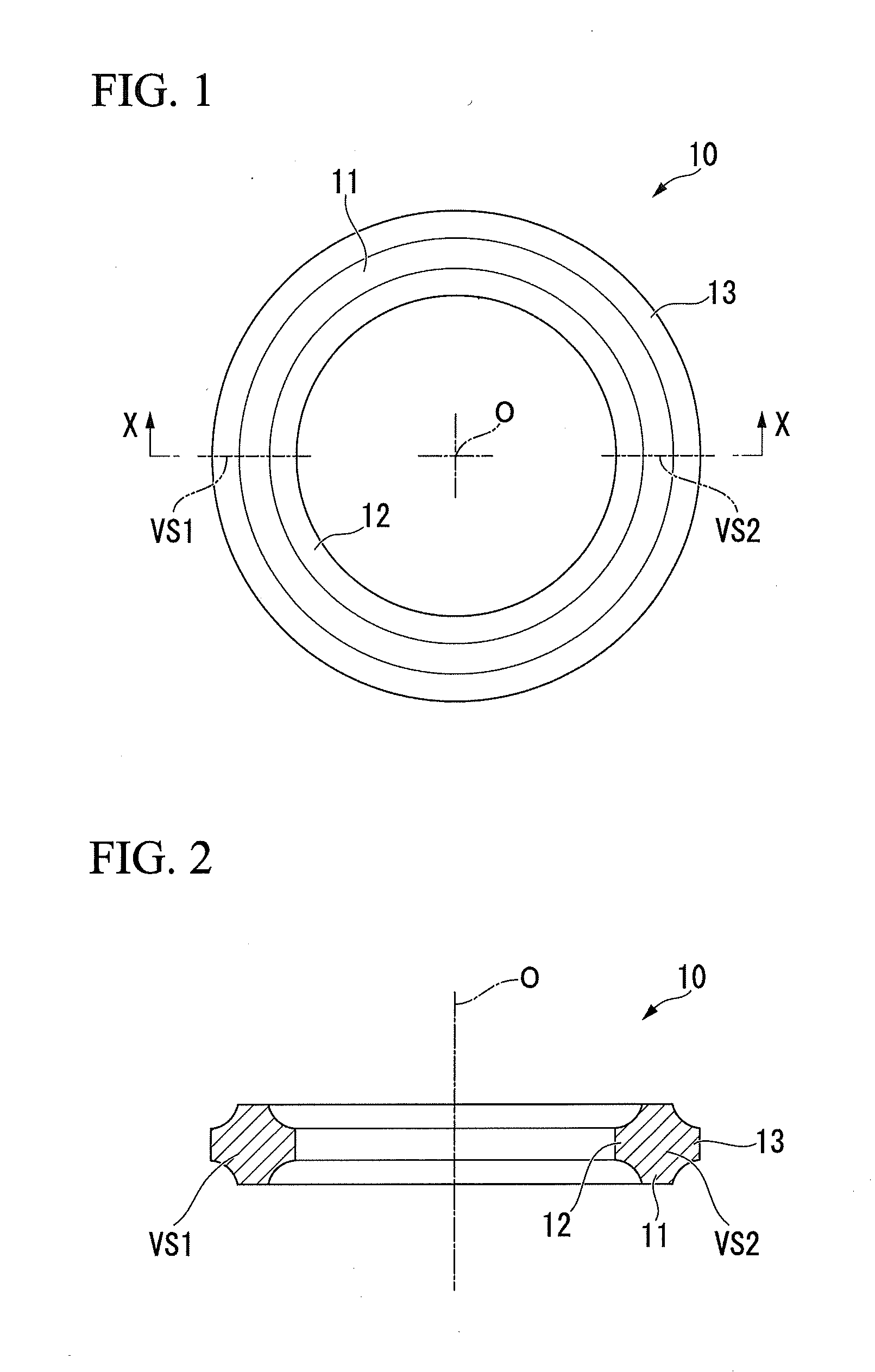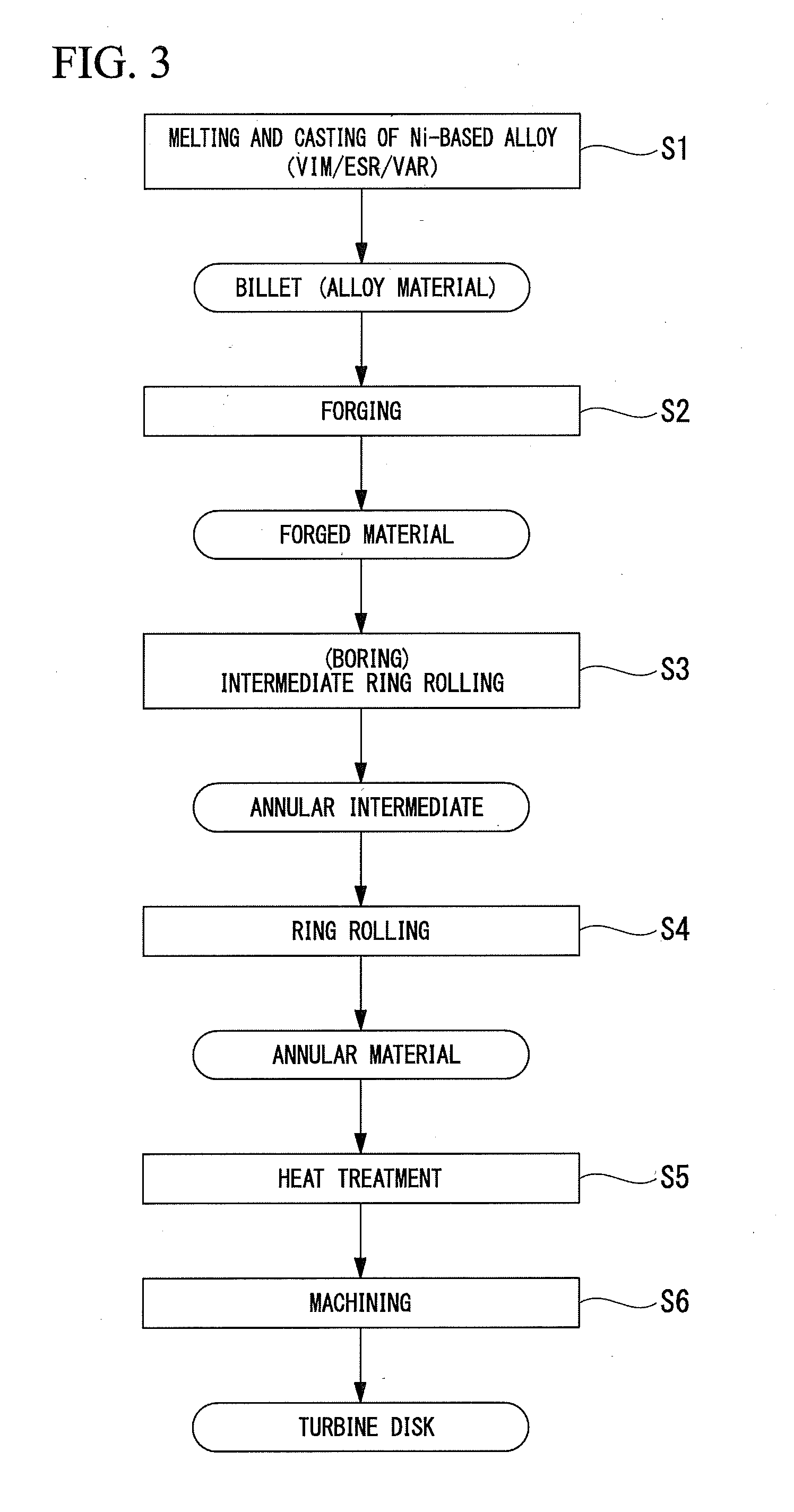Method of manufacturing annular molding
a technology of annular molding and manufacturing method, which is applied in the direction of manufacturing tools, metal rolling arrangements, transportation and packaging, etc., can solve the problems of inability to achieve mechanical strength sufficiently, and inability to achieve desired uniform and fine structure, etc., to ensure the uniform grain size and ensure the effect of grain size uniformity and stability of rolling
- Summary
- Abstract
- Description
- Claims
- Application Information
AI Technical Summary
Benefits of technology
Problems solved by technology
Method used
Image
Examples
example 1
Making of Specimen
[0088]First, the melted metal of the Ni-based alloy Alloy 718 was made. Specifically, melting raw materials were prepared to achieve the composition range of the Ni-based alloy Alloy 718 described in the above-described embodiment. The melted metal was subjected to triple melting processes. Specifically, vacuum induction melting (VIM), electroslag remelting (ESR), and vacuum arc remelting (VAR) were performed thereon, thereby making a columnar billet having a diameter of φ254 mm.
[0089]Next, the forging process was performed on the billet, thereby making the discoid forged material. As the forging, the hot forging in which the billet was heated to a temperature of 1000° C. was performed twice. The first hot forging was performed so that the absolute value εθ1 of the strain in the circumferential direction of the forged material was 0.3, the absolute value εh of the strain in the height direction of the forged material was 0.6, and the ratio εh / εθ1 between the absolu...
example 2
Making of Specimen
[0097]As in Example 1, after making a billet through three melting processes, the forging process was performed on the billet, thereby making the discoid forged material.
[0098]Next, the through-hole was formed in the center portion of the forged material by the water cutter, thereby making the annular intermediate 20. The annular intermediate 20 was made so that the ratio T / H of the thickness T and the height H was T / H=1.4.
[0099]Next, the ring rolling was performed on the annular intermediate 20. As the ring rolling, the hot rolling in which the annular intermediate 20 was heated to a temperature of 1000° C. was performed once. Due to the hot rolling, 0.3 of the absolute value εθ2 of the strain in the circumferential direction of the annular material 10 was exerted. The annular material 10 obtained by subjecting the annular intermediate 20 to the ring rolling was made to have an outside diameter of about φ680 mm, an inside diameter of about $20 mm (that is, the thi...
example 3
Making of Specimen
[0101]As in Example 1, after making a billet through three melting processes, the forging process was performed on the billet, thereby making the discoid forged material. As the forging work, the hot forging in which the billet was heated to a temperature of 1000° C. was performed twice. Each of both the first and second hot forging processes was performed so that the absolute value εθ1 of the strain in the circumferential direction of the forged material was 0.3, the absolute value εh of the strain in the height direction of the forged material was 0.6, and the ratio εh / εθ1 between the absolute values of the strains was 2.
[0102]Next, the through-hole was formed in the center portion of the forged material by the water cutter, thereby making the annular intermediate 20. The annular intermediate 20 was made so that the ratio T / H of the thickness T and the height H was T / H=0.4.
[0103]Next, the ring rolling was performed on the annular intermediate 20. As the ring roll...
PUM
| Property | Measurement | Unit |
|---|---|---|
| temperature | aaaaa | aaaaa |
| diameter | aaaaa | aaaaa |
| temperature | aaaaa | aaaaa |
Abstract
Description
Claims
Application Information
 Login to View More
Login to View More - R&D
- Intellectual Property
- Life Sciences
- Materials
- Tech Scout
- Unparalleled Data Quality
- Higher Quality Content
- 60% Fewer Hallucinations
Browse by: Latest US Patents, China's latest patents, Technical Efficacy Thesaurus, Application Domain, Technology Topic, Popular Technical Reports.
© 2025 PatSnap. All rights reserved.Legal|Privacy policy|Modern Slavery Act Transparency Statement|Sitemap|About US| Contact US: help@patsnap.com



